Malaria is a fever disease caused by plasmodia, unicellular parasites. There exist five species which are pathogenic for humans and induce different forms of the disease: Plasmodium falciparum (Malaria tropica), Plasmodium ovale and Plasmodium vivax (Malaria tertiana), Plasmodium malariae (Malaria quartana) and Plasmodium knowlesi – a species that was only recently recognized to be harmful for humans. One part of the parasite’s life cycle occurs in mosquitos of the genus Anopheles which transmit the infectious form to humans. Here, the parasite subsequently proliferates asexually via different developmental stages.
Through the bite of an infected mosquito, the parasite enters the human blood circulation and reaches the liver cells. Within five to 18 days, depending on the respective species, the protozoon develops intracellularly into a schizozoite, a multinucleated cell which gradually fills up the host cell and finally dissociates into numerous cells called merozoites. Eventually, the host cell bursts and the merozoites are released and end up in the blood stream again, now attacking red blood cells. Within the erythrocytes, the parasite develops into new schizozoites. With the destruction of the red blood cells, the resulting merozoites are released and infect more erythrocytes (see image). Those waves of erythrocyte destruction lead to the disease-characteristic fever episodes of the patients.
About 40% of the world’s population lives in regions endemic for malaria. Approximately 200 millions of them fall ill every year, 600,000 people die, of whom most are children. With this, malaria is accepted as one of the most prominent infectious diseases and every year on April 25th, the WHO and its partners arrange the World Malaria Day to raise awareness for this worldwide issue.
As soon as a patient returns with an undefined fever disease from a stay in tropical regions, malaria is considered. Diagnostic gold standard is the microscopic detection of plasmodia within blood samples of the individual. Experienced physicians may also differentiate the five species by means of their morphology.
Serological tests, such as the Anti-Plasmodium ELISA (IgG), are not well suited for the diagnostics of acute infections. However, the determination of specific antibodies may indicate a previous contact with the parasite or a chronic or latent infection. Thus, serological analyses may be of high importance in blood bank screening or in epidemiological studies. According to these demands, the Anti-Plasmodium ELISA (IgG) combines specific antigens of all five human pathogenic species within one well. If antibodies against one of these species are present within the serum, these will be detected with very high sensitivity.
